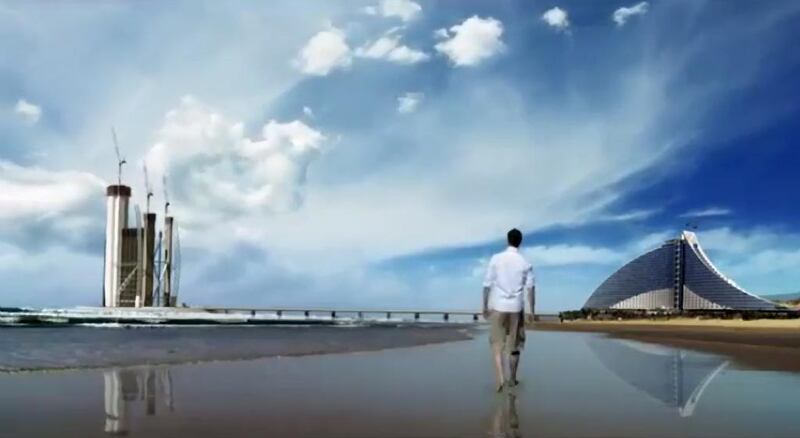Sometimes the Internet can act in a dream-like manner, helping to resurrect forgotten pieces of information when unexpected links and new connections are made.
That was certainly the case at the start of this year when a short film was given a new lease of life thanks to its reposting on a Facebook page dedicated to Dubai.
The film begins with a black and white still of the city from a time, just before 1979, when the road between Abu Dhabi and Dubai was the only significant man-made mark visible in the landscape.
Within seconds, however, the action begins as towers begin to sprout along the road’s length and as miniature cranes whirl like the hands on a stopwatch, more than three decades of development unfold in minute detail floor-by-floor, building-by-building and block-by-block.
The response to the film since it was reposted on January 7 has almost been as remarkable as the development it depicts, and, thanks to 1.7 million views, more than 2,000 shares and more than 5,600 likes, it briefly earned itself a place in Facebook’s trending list, a chart normally reserved for comedic videos and celebrity antics.
The appearance brought the film back to the attention of its maker. “We thought, ‘Really, has nobody got anything better to watch? Surely the UAE has got better television than watching YouTube?’” laughs Nigel Hunt, the chief executive of Black Rabbit Agency Group (Brag), a London-based media company that specialises in computer-generated visualisations.
In 2010, Brag had been asked to "make a city" for the two-minute show reel of a new BBC TV mini-series Supersized Earth, that would tell the story of how humanity has "redesigned our planet to build the modern world". Hunt turned instinctively to a city he knew well, Dubai.
“We looked at cities in Asia, but from my experience in the Gulf, Dubai was the most eye-catching because in just 20 years plus you could look at it and see what it had achieved,” the New Zealander explains.
Delving into the BBC archive, Hunt’s team tried to find out when each building along the Sheikh Zayed Road was actually built and in what order to show Dubai’s buildings rising as accurately as possible.
Originally trained as an architectural designer, Hunt’s team now spends more than 50 per cent of its time visualising the dreams of UAE developers such as Emaar, for whom Brag recently produced a Dubai Creek Harbour time-lapse, using powerful computer technology and digital versions of one of cinema’s oldest visual tricks.
“The techniques are the same that you see today in Hollywood feature films,” Hunt says, describing the digital matte painting technique that allows Brag to clothe crude 3-D computer-generated cityscapes with photorealistic 2-D facades.
“That allows you to put a camera inside the [digital] model, and as long as you aren’t revealing any of the faces that aren’t clothed you can actually move the camera around,” he explains.
Used since the earliest days of cinema to fool audiences, physical matte paintings were originally placed between a camera and the live action to add illusory and fantastical scenery to modest locations and sets.
Ralph McQuarrie's matte paintings for the original Star Wars movie are often held up as masterpieces of the art, but the technique was also used on earlier films such as The Wizard of Oz, where they formed the basis for much of the Emerald City.
The architect Adrian Smith, designer of the Burj Khalifa, has acknowledged his debt to the 1939 movie publicly.
"That was in my mind as I was designing Burj Dubai, although in a subliminal way," Smith told the Chicago Sun-Times in 2005.
“I didn’t research the way it looked – I just remembered the glassy, crystalline structure coming up in the middle of what seemed like nowhere.”
That image of imaginary towers, rising miraculously in a place that knows no limits also haunts Brag’s film, whose power stems not just from its technical wizardry but from its fidelity to an existing visual grammar that’s widespread.
Dubai’s self-constructed identity rests on a mantra of unbridled ambition, development and progress that frequently employs “before” and “after” images of its urban landscape to communicate and legitimise its key idea: here is a place where visions are not only promised but delivered.
“Vision drove ambition” and “vision drives a city” proclaims a recent Dubai Tourism ad over using contrasting shots of the Emirates Golf Club as it stood in 1990 and the same scene today, heralding Dubai as a place “where vision is tradition”.
But that vision is not only predicated on an image of the desert as a blank slate upon which even the most experimental schemes can be developed without constraint, it also rests on a spectacular notion of reality that’s infused with illusion.
When Supersized Earth's presenter, Dallas Campbell, climbed to the top of the Burj Khalifa, he did so to clean the tower's windows and to take in a view that leaves no room for the city's earlier history or its landscape from the time before the latest "vision" arrived.
For Nigel Hunt and the other fabricators of Dubai’s modern identity – the architects and planners, developers and estate agents – images and storytelling are the only meaningful way to envisage the future and to visualise the emirate’s most grandiose ideas.
“It’s more than just architecture,” the special effects man insists. “This is about selling dreams.”
Nick Leech is a feature writer at The National.
nleech@thenational.ae





